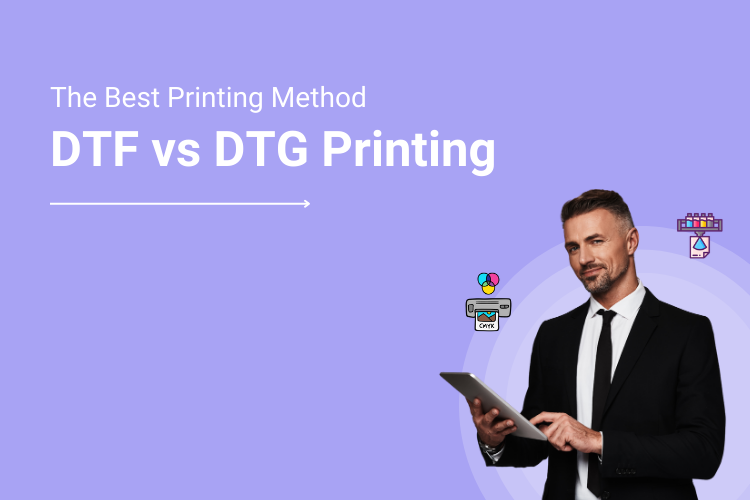With digitalization seeping into every industry, things are nothing like ever before. Textile printing too, is now a part of this change, and due to the introduction of innovative technology in the printing industry, we now have various cutting-edge print techniques that are worth praising.
Today, we are going to praise two such dynamic printing methods- Direct-to-garment (DTG) and Direct-to-film (DTF) and compare their precision, vibrancy, and versatility because both are nothing less than a clash of titans.
So, let’s navigate through the vivid landscapes of DTG and DTF printing to help you make an informed decision for your direct to garment business.
Table of Contents
What is DTF Printing?
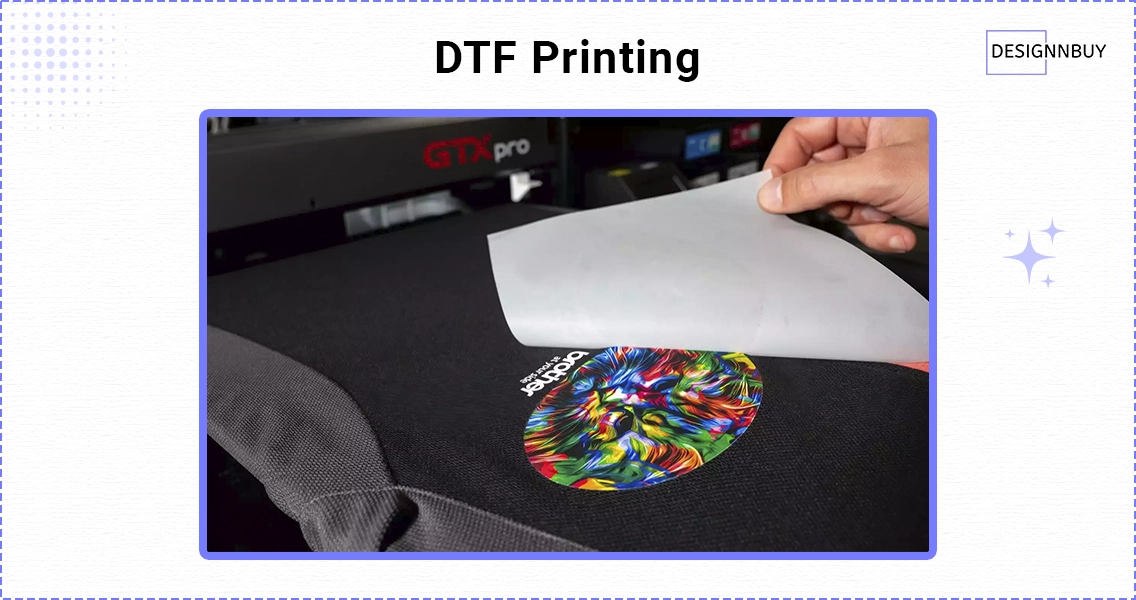
DTF (Direct-to-film) printing is a relatively modern and innovative printing method that involves transferring designs directly onto fabric using a special transfer film. DTF printing method is gaining popularity in the textile and apparel industry for its ability to print vibrant and detailed designs on various types of fabrics including cotton, polyester, blends, etc.
How does DTF printing work?
For the direct transfer of designs onto fabric using a special adhesive film, the Direct-to-film (DTF) printing process involves several steps:
1. Design Creation
The process begins with the creation of a digital design including various colors, gradients, and intricate details using DTF printing software.
2. Printing onto Adhesive Film
The digital design is printed onto a special adhesive film using high-quality DTF printers equipped with DTF-specific inks. These inks are formulated to adhere well to the film.
3. Film Application
The adhesive film, now carrying the printed design, is applied to the fabric. The film adheres securely to the fabric’s surface, creating a bond.
4. Heat Curing
The fabric, with the attached adhesive film, undergoes a heat-curing process which involves exposing the fabric and film to heat, typically through a heat press. The heat serves multiple purposes:
– It causes the adhesive on the film to become tacky and bond with the fabric fibers.
– It cures the DTF inks ensuring that they solidify and become a permanent part of the fabric.
5. Peeling Off the Film
After the heat-curing process, the adhesive film is carefully peeled off from the fabric. The design adheres to the fabric, creating a vibrant and durable print.
6. Post-Treatment (Optional
Depending on the specific DTF system used, there may be an optional post-treatment step that involves washing or applying a fixative to enhance the durability and wash resistance of the print.
Key advantages of DTF printing
DTF printing provides impressive results but it might not work on all materials or designs. Therefore, here are the strengths and considerations upon which it might be a suitable choice for excellent outcomes.
- Direct-to-film printing can provide vibrant and detailed prints, making it a good choice when intricate designs with a wide range of colors are required. If your design includes fine details, gradients, or photographic elements, DTF printing can capture these nuances effectively.
- DTF printing is versatile and can be used on various fabrics as well as a variety of surfaces, including hard substrates like wood and ceramics.
- Direct-to-film printing can be cost-effective for small to medium print runs. If you don’t need a large quantity of garments with the same design, DTF printing might be more economical than traditional screen printing for shorter production runs.
- DTF printing can offer relatively quick turnaround times compared to some other printing methods. If you have a tight deadline for producing custom apparel, DTF printing might be a viable option.
- DTF printing is capable of producing full-color designs on dark garments without the need for a white base layer.
- Direct-to-film printing is suitable for print-on-demand services where you can produce custom designs in response to specific customer orders. It is particularly beneficial for businesses that offer personalized or customized apparel.
- DTF can be used for special effects like raised or textured prints, adding a tactile element to the designs.
- DTF prints are generally durable and wash-resistant, making them suitable for apparel and items that undergo regular washing.
What is DTG Printing?
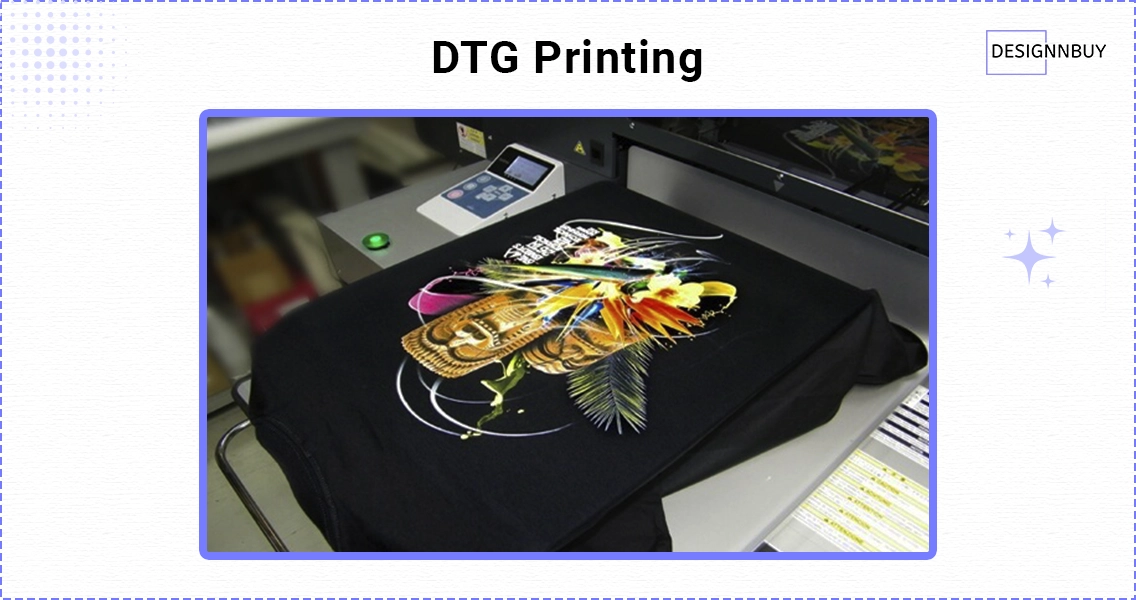
DTG (Direct-to-garment) printing is a modern digital printing technique designed for applying designs, images, and graphics directly onto textiles, particularly garments like t-shirts, hoodies, and various apparel items. In contrast to conventional printing approaches that require the creation of separate screens for each color in the design, DTG printers utilize inkjet technology to directly deposit water-based inks onto the fabric’s surface.
How does DTG printing work?
In the direct-to-garment printing method, the ink is sprayed directly onto the garment to obtain high-quality, full-color DTG prints which require certain steps to be followed and they are:
1. Design Preparation
Just like in the DTF printing business, DTG printing also begins with the creation of a digital design using DTG printing software including a full-color layer and intricate details.
2. Pre-treatment (optional for dark garments)
For dark-colored garments, a pre-treatment solution may be applied to the fabric before printing to help the inks adhere better to dark textiles and enhance color vibrancy. It is usually heat-set or dried before the printing process.
3. Garment Placement
The garment is laid flat on the platen of the DTG printer, ensuring that it is properly aligned for accurate printing.
4. Printing
The DTG printer uses a specialized inkjet mechanism to apply water-based inks directly onto the fabric. The printer moves back and forth across the garment, depositing the ink in the desired pattern based on the digital design.
5. Ink Absorption
The water-based inks used in DTG printers are designed to be absorbed by the fibers of the fabric to achieve vibrant and durable prints.
6. Curing Process
After printing, the garment typically undergoes a curing process involving heat pressing or using a conveyor dryer. The purpose of curing is to set the inks into the fabric, ensuring that the print is durable, washable, and resistant to fading.
7. Quality Control
The printed garment undergoes quality control checks to ensure that the colors are accurate, the design is sharp, and there are no defects.
8. Finished Product
Once the curing and quality control processes are complete, the finished garment is ready for packaging and delivery.
Key advantages of DTG printing
Direct-to-garment (DTG) printing, commonly utilized by DTG businesses, is a suitable choice for certain situations and applications. Here are some scenarios in which you might consider choosing DTG printing:
- Like DTF, DTG printing is also well-suited for on-demand printing and customization. It allows for the easy printing of individualized designs or small batches on your DTG website.
- DTG prints also prove to be a better choice for small to medium-sized print runs as it eliminates the need for any kind of setup like with traditional screen printing. Hence is a cost-effective solution if you need a limited quantity of garments with complex and colorful designs. You can learn more about screen printing software.
- If your design includes a wide range of colors or intricate details, DTG printing is a good choice. It can reproduce vibrant and detailed designs without the need for color separations or multiple screens.
- DTG printing methods offer a relatively quick turnaround time compared to traditional methods like screen printing, making it suitable for projects with tight deadlines or on-demand fulfillment.
- When your direct to garment prints design requires printing photos, elements, or gradients, DTG printing is capable of reproducing these details accurately. It allows for a high level of detail and shading.
- DTG inks are water-based, resulting in a softer feel on the fabric compared to some other printing methods. It is particularly appealing for garments where a soft and comfortable feel is desirable.
- If you need to print garments with variable data, such as individual names or numbers, DTG is a practical choice. Each item can have a unique design without incurring additional setup costs.
- Direct-to-garment is suitable for designs with intricate details, small text, and complex patterns. It allows for high-resolution printing, capturing fine details accurately.
DTF vs DTG Printing: Key Differences Explained
Both printing methods contribute the best in their way and even appear to be quite similar however, there are some differences and categories that make them different from one another. So, let’s get started with a direct-to-film vs direct-to-garment comparison across various factors:
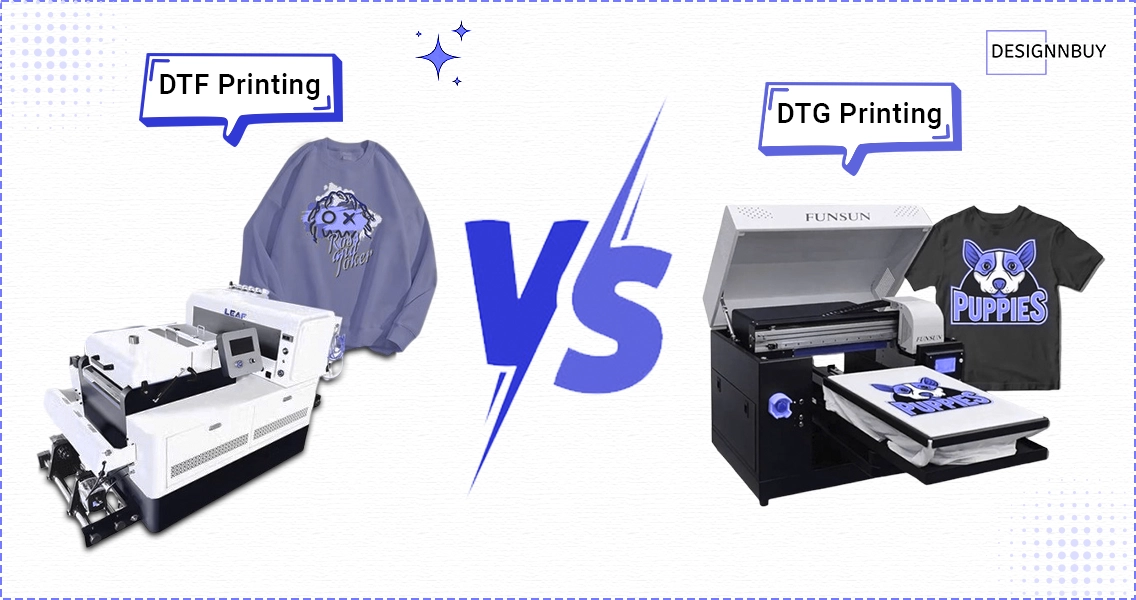
DTG Prints:
1. Print Quality
Pros: DTG printing provides high-resolution prints with excellent detail, making it suitable for intricate designs and photographic reproductions.
Cons: The quality may vary based on the garment material and color. Dark fabrics may require additional pre-treatment.
2. Print Complexity
Pros: Suitable for complex and detailed designs, including gradients and fine lines.
Cons: Limited by the type of fabric and color; dark fabrics may require pre-treatment.
3. Color Vibrancy
Pros: Can achieve vibrant and full-color prints.
Cons: The vibrancy may be affected on dark fabrics.
4. Fabric Suitability
Pros: Works well on light garments, and can be used on some dark fabrics with pre-treatment.
Cons: Limited suitability for very dark fabrics.
5. Quantity
Pros: Ideal for small to medium print runs.
Cons: May become less cost-effective for large quantities.
6. Flexibility
Pros: Offers flexibility for on-demand printing and customization.
Cons: Production speed may not match that of some other methods.
7. Eco-friendliness
Pros: Water-based inks make it relatively eco-friendly.
Cons: Still generates some waste in the form of cleaning solutions and consumables.
8. On-demand Fulfillment
Pros: Well-suited for on-demand and personalized printing.
Cons: Production time may not be as rapid as other methods.
9. Upfront Investment
Pros: Generally, the initial investment is lower compared to some other digital printing methods.
Cons: The actual DTG machine and inks can add up the cost.
10. Maintenance
Pros: Fewer components to maintain and printheads and parts can be replaced, extending the printer’s lifespan.
Cons: Routine maintenance adds to operational costs and replacements can be costly.
DTF Prints:
1. Startup Costs
Pros: Lower compared to some other methods.
Cons: Variable based on the type of DTF equipment.
2. Environmental Impact
Pros: DTF printing uses fewer chemicals and water contributing to the reduction in environmental impact.
Cons: The production and disposal of specialty materials may have environmental implications, and businesses should consider the sustainability of these consumables.
3. Consumables
Pros: Consumables such as films and powders are often more affordable.
Cons: Specialty consumables are required.
4. Production Time
Pros: Can offer faster production times compared to DTG printing for some applications.
Cons: Printing and curing times vary.
5. Order Quantity
Pros: Suitable for small to medium-sized orders.
Cons: May have limitations on very large orders.
6. Print Quality
Pros: Can produce high-quality DTF prints with good detail.
Cons: Quality can be affected by the film and powder application process.
7. Versatility
Pros: Versatile for a variety of fabric types and colors.
Cons: May not be as versatile as DTG for very dark fabrics.
8. Color Vibrancy
Pros: Can achieve vibrant colors.
Cons: Some color limitations compared to DTG.
9. Durability
Pros: Prints are generally durable and wash-resistant.
Cons: Durability may vary based on the application process.
10. Maintenance
Pros: Generally requires less maintenance.
Cons: Routine maintenance is still necessary for optimal performance.
In conclusion, the two printing methods have distinct advantages and drawbacks. The decision between these methods hinges on the particular demands of your project, financial constraints, and the envisioned attributes of the results. A comprehensive assessment of your requirements is advised, and if feasible, seeking guidance from printing experts can aid in selecting the most fitting method for your application.
How to Choose Between DTF and DTG Printing: A Step-by-Step Guide
DTF vs DTG is a never-ending battle, therefore follow the below steps while deciding the printing method for your printing business.
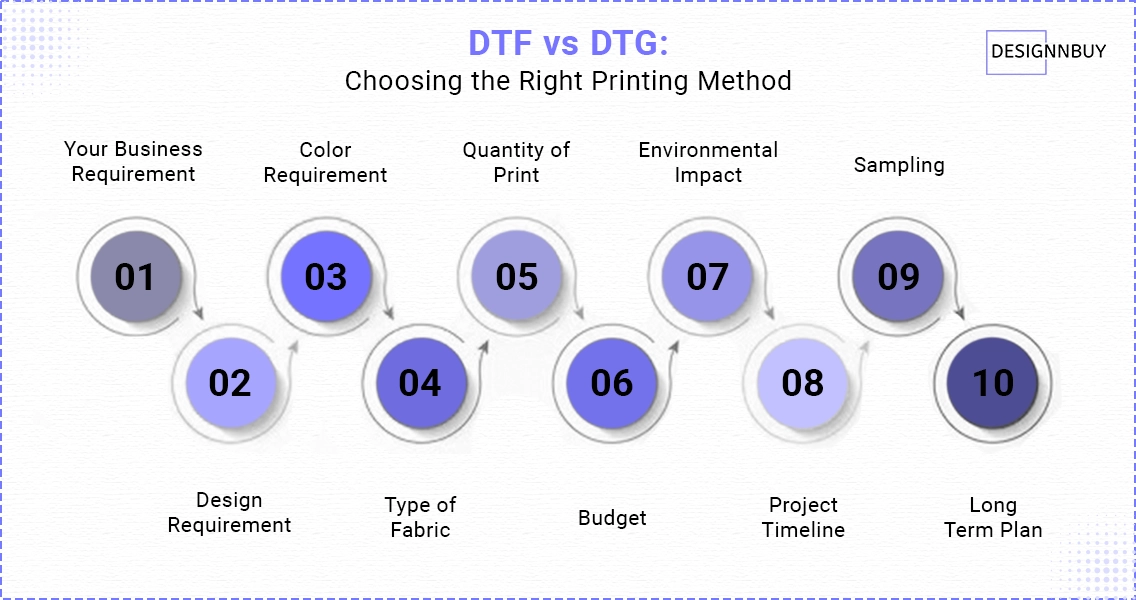
Step 1 – Clearly outline the specifications of your t-shirt printing business or project. Consider the type of products, design complexity, print quality, and any specific features required.
Step 2 – If your designs are intricate with fine details, gradients, or photographs, Direct-to-garment printing might be more suitable. most DTF printers can handle complex designs, but the level of detail may vary.
Step 3 – Consider the color vibrancy and accuracy needed for your designs. DTG excels in full-color printing, while DTF can produce vibrant colors but may have some limitations.
Step 4 – Determine the type and color of the fabric or substrate you plan to print on. DTG is well-suited for light garments, while DTF is more versatile for dark fabric and can be applied to various fabrics.
Step 5 – Evaluate the quantity of prints you need. DTG is efficient for small to medium runs, and its on-demand capabilities make it suitable for personalized printing. DTF is also effective for short to medium runs but may have variable setup times.
Step 6 – Assess your budget constraints. DTG printing involves lower upfront costs, but the DTG machines can be relatively expensive. DTF printer also generally has a lower initial investment, depending on the chosen technology.
Step 7 – Consider the environmental impact of each method. DTG’s water-based inks are more eco-friendly, while DTF involves considerations for film and powder waste.
Step 8 – Take into account your project timeline. Direct-to-garment offers quick turnaround times, making it suitable for projects with tight deadlines. DTF can provide fast production times, but the specific technology used may influence speed.
Step 9 – Request or create sample prints using both DTG and DTF methods to assess the actual output. If possible, consult with printing professionals to gain insights based on their expertise.
Step 10 – Think about the long-term requirements of your project. If you anticipate frequent design changes or on-demand printing, DTG may be preferable. For consistent designs and larger quantities, DTF or other methods might be more cost-effective.
By systematically considering these factors, you can make a well-informed decision on which of the DTF vs DTG is the most suitable method for your specific printing application.
In conclusion: Choosing The Right Printing Method For Your Web to Print Business
Whether it’s a DTG or DTF print, both methods have their advantages and disadvantages. Your budget and specific requirements should guide the final decision. Experiment with both techniques on different products if you have a difficult time choosing between the two.
Trying each method on different items allows you to discover which one enhances your designs most effectively. Ultimately, the choice is yours, and embracing experimentation can lead to finding the method that truly makes your designs stand out.
Pair Your DTF or DTG Printing Machine with a Powerful Web-to-Print Storefront
Whether you use DTF or DTG printers — or both — your online store should be just as advanced as your print equipment.
With DesignNBuy, you can:
🎨 Let customers personalize t-shirts, hoodies & more in real-time
📦 Automatically send print-ready files to your DTF/DTG machine queue
🧵 Ensure smooth order-to-production flow tailored to your printing method
Sell custom apparel faster, smarter, and with fewer errors. Book a Free Demo Today
FAQs
Which is better DTG or DTF?
The choice between DTG and DTF printing methods depends on your specific project requirements, and understanding the strengths of each method will guide you toward the most suitable printing solution for your business.
Which method is more cost-effective for small quantities or on-demand printing?
Both DTG and DTF printing are suitable for small quantities and on-demand printing.
How to decide which method is best for a business?
Consider your requirements, product offerings, and budgets, and then decide. If needed seek professional help to make informed decisions.
Is there a significant difference in print quality between DTG and DTF printing?
Both methods can achieve high-quality prints. DTG is known for its soft feel on garments and is excellent for reproducing photographic images. DTF printing can also produce detailed and durable prints, with the added advantage of applying to various surfaces.
If you’re looking for content related to printing methods, you can consider the following topics:
This blog post was last updated in July 2025.

